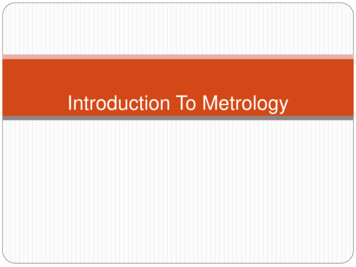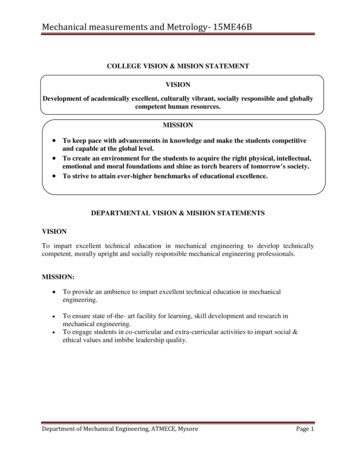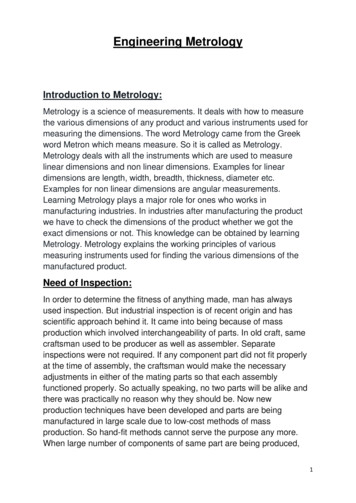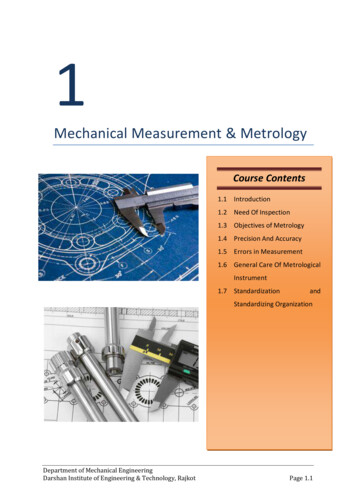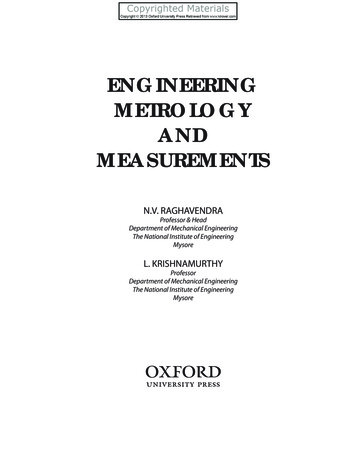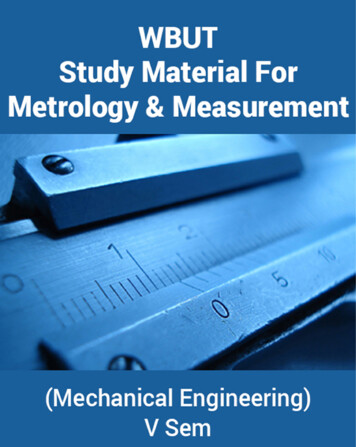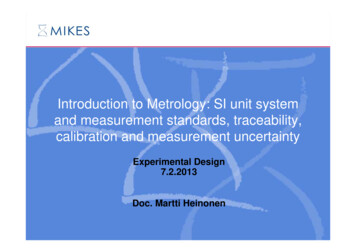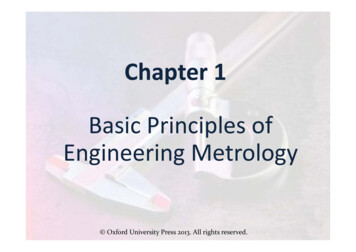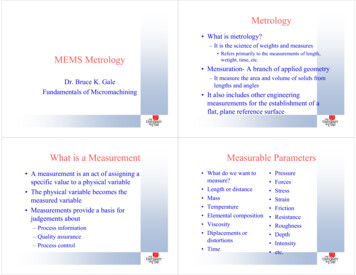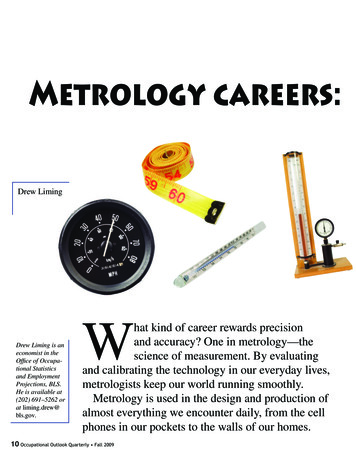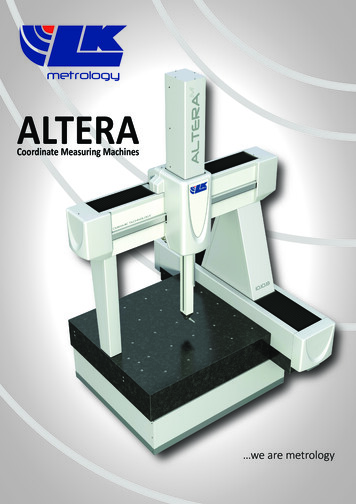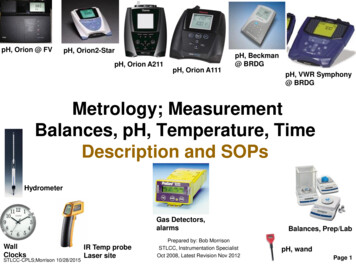
Transcription
Engineering MetrologyN. SinhaMechanical Engineering DepartmentIIT Kanpur
IntroductionCross-section of a machine-tool slideway.The width, depth, angles and other dimensions allmust be produced and measured accurately for themachine tool to function as expected.
Metrology Metrology is the science of measurement Dimensional metrology is that branch of Metrologywhich deals with measurement of “dimensions“ ofa part or workpiece (lengths, angles, etc.) Dimensional measurements at the required level ofaccuracy are the essential link between the designers’intent and a delivered product.
Dimensional Metrology Needs Linear measurements Angular measurements Geometric form measurements Roundness Straightness Cylindricity Flatness, etc Geometric relationships Parallel, perpendicular, etc. Concentric, runout, etc. Controlled surface texture
Types of Measurement and Instruments Used
Basic Measurement Devices
Analog and Digital Micrometers(a) A vernier (analog) micrometer. (b) A digital micrometer with a rangeof 0 to 1 in. (0 to 25 mm) and a resolution of 50 µin. (1.25µm). It isgenerally easier to read dimensions on this instrument compared to theanalog micrometer.
Angle Measuring Instruments
Measuring Roundness
Profile MeasurementMeasuring gear-tooth thickness and profile with (a) a gear-toothcaliper and (b) balls and a micrometer.Source: American Gear Manufacturers Association.
Introduction to TolerancesCan more than one or multiple parts be produced withexactly same dimensions?Why?
Tolerance“the allowable deviation from a standard,eg: the range of variation permitted inmaintaining a specified dimension in amachined piece.”Webster
Why is it necessary?
Consequences
Specification
Some DefinitionsBasic Size: The size with reference to which the limits of size arefixed.Actual Size: Actual measured dimension of the part.Zero Line: It is a straight line corresponding to the basic size. Thedeviations are measured from this line. The positive and negativedeviations are shown above and below the zero line respectively.
Some DefinitionsLimits of Size: The two extreme permissible sizes of a partbetween which the actual size should lie.Maximum Limit of Size: The greater of the two limits of size.Minimum Limit of Size: The smaller of the two limits of size.Shaft: A term used by convention to designate all externalfeatures of a part, including those which are not cylindrical.Hole: A term used by convention to designate all internal featuresof a part, including those which are not cylindrical.
Some DefinitionsAllowance: It is the difference between the basic dimensions ofthe mating parts.When the shaft size is less than the hole size, then the allowance ispositive and when the shaft size is greater than the hole size, thenthe allowance is negative.Tolerance: It is the difference between the upper limit and lowerlimit of a dimension.
Some DefinitionsTolerance Zone: It is the zone between the maximum and minimumlimit size.Upper Deviation: It is the algebraic difference between the maximumsize and the basic size.The upper deviation of a hole is represented by a symbol ES (EcartSuperior) and of a shaft, it is represented by es.Lower Deviation: It is the algebraic difference between the minimumsize and the basic size.The lower deviation of a hole is represented by a symbol EI (EcartInferior) and of a shaft, it is represented by ei.Shaft
Some Definitions
Specification of DTUnilateral ToleranceIn this system, the dimension of a part is allowed to vary only onone side of the basic size, i.e. tolerance lies wholly on one side ofthe basic size either above or below it.Bilateral ToleranceIn this system, the dimension of the part is allowed to vary onboth the sides of the basic size, i.e. the limits of tolerance lie oneither side of the basic size.
Specification of DT
ExerciseQ1. Type?Bilateral, Unilateral, Unilateral.Q2. Tolerance?0.015, 0.005, 0.004Q3. Express in limit form?
Tolerance Stacks
Effect of Tolerance Stacking
FitA fit may be defined as the degree of tightness andlooseness between two mating parts.
Clearance Fit In clearance fit, an air space or clearance exists between theshaft and hole. Such fits give loose joint. A clearance fit has positive allowance, i.e. there is minimumpositive clearance between high limit of the shaft and low limitof the hole. Allows rotation or sliding between the mating parts.
Types of Clearance FitLoose FitIt is used between those mating parts where no precision isrequired. It provides minimum allowance and is used on loosepulleys, agricultural machineries etc.Running FitFor a running fit, the dimension of shaft should be smallerenough to maintain a film of oil for lubrication. It is used inbearing pair etc.Slide Fit or Medium FitIt is used on those mating parts where great precision isrequired. It provides medium allowance and is used in toolslides, slide valve, automobile parts, etc.
Interference Fit A negative difference between diameter of the hole and theshaft is called interference. In such cases, the diameter of the shaft is always larger thanthe hole diameter. It used for components where motion, power has to betransmitted.Interference exists between the high limit of hole and lowlimit of the shaft.
Types of Interference FitShrink Fit or Heavy Force FitIt refers to maximum negative allowance. In assembly of thehole and the shaft, the hole is expanded by heating and thenrapidly cooled in its position. It is used in fitting of rims etc.Medium Force FitThese fits have medium negative allowance. Considerablepressure is required to assemble the hole and the shaft. It isused in car wheels, armature of dynamos etc.Tight Fit or Force FitOne part can be assembled into the other with a hand hammeror by light pressure. A slight negative allowance exists betweentwo mating parts (more than wringing fit). It gives a semipermanent fit and is used on a keyed pulley and shaft, rockerarm, etc.
Transition Fit It may result in either clearance fit or interference fitdepending on the actual value of the individual tolerances ofthe mating components. Transition fits are a compromise between clearance andinterference fits. They are used for applications where accurate location isimportant but either a small amount of clearance orinterference is permissible.
Types of Transition FitPush Fit or Snug FitIt refers to zero allowance and a light pressure is required inassembling the hole and the shaft. The moving parts show leastvibration with this type of fit.Force Fit or Shrink FitA force fit is used when the two mating parts are to be rigidlyfixed so that one cannot move without the other. It eitherrequires high pressure to force the shaft into the hole or thehole to be expanded by heating. It is used in railway wheels, etc.Wringing FitA slight negative allowance exists between two mating parts inwringing fit. It requires pressure to force the shaft into the holeand gives a light assembly. It is used in fixing keys, pins, etc.
Metrology Metrology is the science of measurement Dimensional metrology is that branch of Metrology which deals with measurement of “dimensions“ of a part or workpiece (lengths, angles, etc.) Dimensional measurements at the required level of accuracy are the essential link between the designers’ intent and a delivered product.File Size: 984KB
